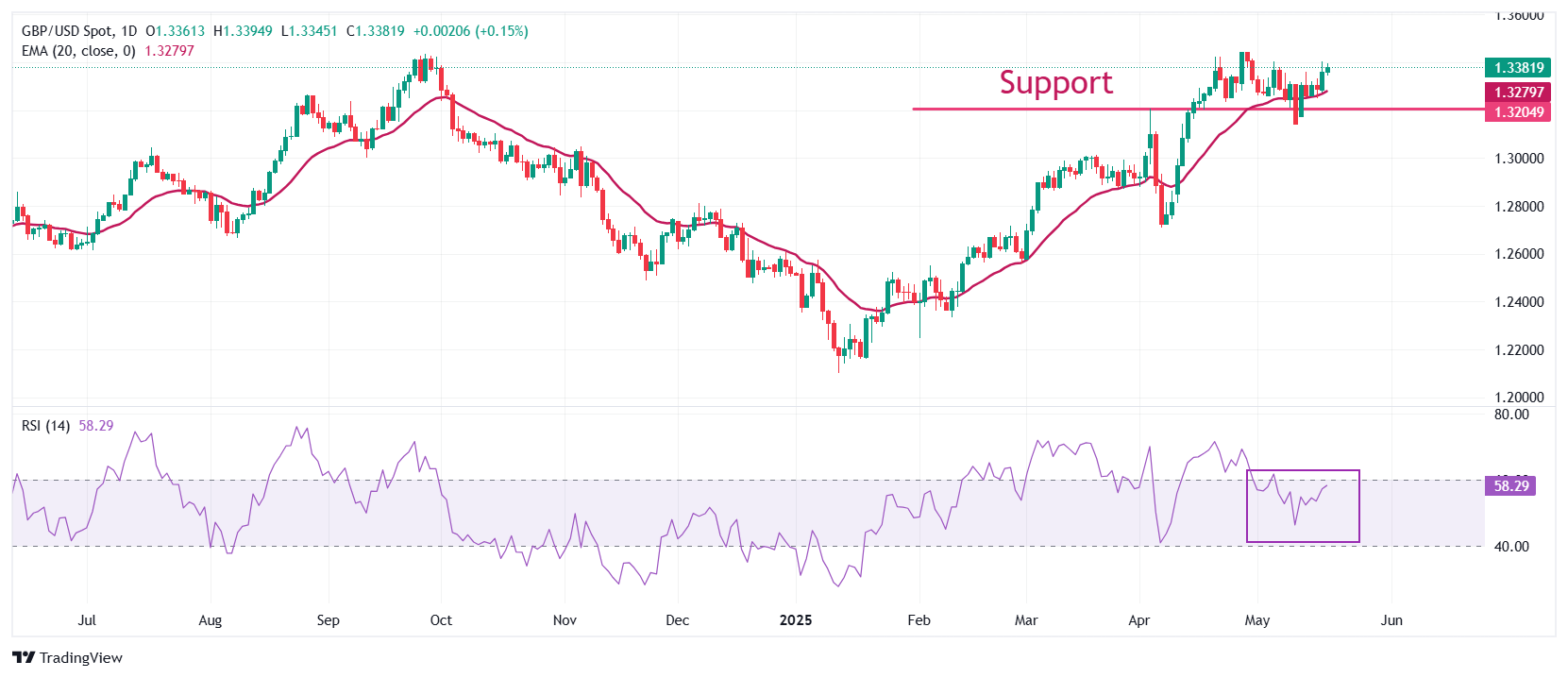-
The Pound Sterling climbs toward 1.3380 against the US Dollar amid Moody’s downgrade of US sovereign debt and renewed US-China trade tensions.
-
China criticizes the US for jeopardizing recent trade talks following Washington’s global warning against Huawei AI chips.
-
The UK achieves a "reset" in relations with the EU, following successful trade agreements with India and the US.
The Pound Sterling (GBP) strengthened across most major currencies on Tuesday, excluding select safe-haven assets, as the United Kingdom deepened post-Brexit ties with the European Union (EU) through a new agreement on trade, defense, and security. This marks the UK’s third major bilateral deal in May, following agreements with the United States and India.
Key elements of the UK-EU deal include a Sanitary and Phytosanitary (SPS) agreement to reduce checks on animal and plant-based products, the UK’s participation in the EU’s landmark defense spending initiative, and a £360 million investment into Britain’s fishing sector. The enhanced cooperation comes amid rising global trade uncertainties triggered by US President Donald Trump’s reciprocal tariff policies, and is seen as mutually beneficial for both the UK and EU economies.
Domestically, all eyes are on the UK Consumer Price Index (CPI) data for April, due Wednesday. Markets anticipate a rise in core inflation to 3.7% from 3.4% in March, and headline inflation to 3.3%, up from 2.6%, suggesting growing price pressures. Such an outcome could lead investors to scale back expectations of further Bank of England (BoE) rate cuts.
Earlier this month, the BoE lowered interest rates by 25 basis points to 4.25%, with a 7-2 vote in favor and a tone of cautious easing. Notably, Chief Economist Huw Pill and MPC member Catherine Mann opposed the cut. Speaking during European trading hours, Pill reiterated that while the disinflation trend remains intact, the current pace of rate reductions may be too fast given inflation risks. He emphasized that his vote was meant to pause the sequence of cuts—not to end the policy of gradual easing altogether.
Daily Digest Market Movers: Pound Sterling Gains Against US Dollar Amid US Debt Downgrade
- The Pound Sterling edged higher to around 1.3365 against the US Dollar (USD) during Tuesday’s European trading session, marking a second consecutive day of gains as the US Dollar remained under pressure following Moody’s one-notch downgrade of the US sovereign credit rating. The US Dollar Index (DXY), which measures the Greenback against six major currencies, struggled to hold above the 100.00 level.
- On Friday, Moody’s lowered the US long-term issuer and senior unsecured ratings from Aaa to Aa1, citing concerns over the nation’s growing $36 trillion debt burden. This downgrade raised investor fears about US assets, driving a notable spike in US bond yields. The 10-year Treasury yield initially surged to a one-month high near 4.56%, before retreating slightly to around 4.45%.
- Adding to the Greenback’s woes, China accused the US of undermining recent high-level trade talks held in Geneva, following US Commerce Department warnings against the use of Huawei Technologies’ AI chips and Chinese AI models. A spokesperson from China’s Commerce Ministry labeled the US guidance as “discriminatory” and “market distorting,” demanding Washington “correct its mistakes.”
- According to a Bloomberg report, the US Commerce Department clarified that the use of Huawei Ascend chips violates US export controls and cautioned about the risks of US AI chips being used to train Chinese AI models.
- Meanwhile, investors remain cautious ahead of further Federal Reserve (Fed) policy signals, as Fed officials continue to emphasize patience and the need for more data amid recent economic shifts. On Monday, Atlanta Fed President Raphael Bostic said inflation is expected to take longer to return to the 2% target and forecasted just one rate cut this year.
Technical Analysis: Pound Sterling Holds Steady Near 1.3365

The Pound Sterling remains firm around 1.3365 against the US Dollar on Tuesday, maintaining its position above the 20-day Exponential Moving Average (EMA) at approximately 1.3280, indicating a bullish near-term trend.
The 14-day Relative Strength Index (RSI) sits near the upper end of the 40.00-60.00 range, with a potential bullish breakout if it surpasses 60.00.
On the upside, the key resistance level to watch is the three-year high at 1.3445, while the psychological support at 1.3000 is expected to provide strong downside protection.





